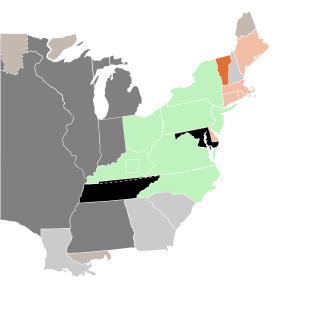
The 13th United States Congress was a meeting of the legislative branch of the United States federal government, consisting of the United States Senate and the United States House of Representatives. It met in Washington, D.C. from March 4, 1813, to March 4, 1815, during the fifth and sixth years of James Madison's presidency. The apportionment of seats in the House of Representatives was based on the 1810 United States census. Both chambers had a Democratic-Republican majority. The first two sessions were held at the Capitol building while the third, convened after the Burning of Washington, took place in the First Patent Building.

Jeremiah Morrow was a Democratic-Republican Party politician from Ohio. He served as the ninth governor of Ohio, and was the last Democratic-Republican to hold that office. He also served as a United States Senator and a member of the United States House of Representatives from Ohio. He also served in the Ohio Senate.

Thomas Worthington was an American politician who served as the sixth governor of Ohio.

These are tables of congressional delegations from Ohio to the United States House of Representatives and the United States Senate.
The 1814–15 United States House of Representatives elections were held on various dates in various states between April 26, 1814, and August 10, 1815. Each state set its own date for its elections to the House of Representatives before the first session of the 14th United States Congress convened on December 4, 1815. They occurred during President James Madison's second term. Elections were held for all 182 seats, representing 18 states.

The 1812–13 United States House of Representatives elections were held on various dates in various states between August 3, 1812, and April 30, 1813. Each state set its own date for its elections to the House of Representatives before the first session of the 13th United States Congress convened on May 24, 1813. They coincided with James Madison being re-elected president.

Samuel Fenton Cary was an American politician who was a member of the U.S. House of Representatives from Ohio and significant temperance movement leader in the 19th century. Cary became well known nationally as a prohibitionist author and lecturer.
William Addams was an American politician who served as a Pennsylvania State Representative and United States Congressman, serving two terms in the U.S. House from 1825 to 1829.

The 1814–15 United States Senate elections were held on various dates in various states. As these U.S. Senate elections were prior to the ratification of the Seventeenth Amendment in 1913, senators were chosen by state legislatures. Senators were elected over a wide range of time throughout 1814 and 1815, and a seat may have been filled months late or remained vacant due to legislative deadlock. In these elections, terms were up for the senators in Class 1.

Pennsylvania held its elections October 11, 1814.
Massachusetts held its elections November 7, 1814. State law required a majority vote for election, which was not met in two districts, leading to a second election January 6, 1815.

The 1814 United States House of Representatives election in Delaware was held on October 4, 1814.

New Hampshire held its election August 29, 1814.

New Jersey held its election October 10–11, 1814. The state returned to an at-large basis for electing its representatives, abolishing the short-lived districts of the previous election.

A special election was held in Ohio's 6th congressional district on June 7, 1814, to fill a vacancy left by the resignation of Reasin Beall (DR) to accept an appointment to the Federal Land Office in Wooster, Ohio.

Maryland held its elections October 3, 1814.

South Carolina held its elections October 10–11, 1814.

Kentucky held its elections August 3, 1814.

The United States state of Virginia held elections in April 1815.
This page is based on this
Wikipedia article Text is available under the
CC BY-SA 4.0 license; additional terms may apply.
Images, videos and audio are available under their respective licenses.
















